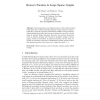2304 search results - page 40 / 461 » On the Vulnerability of Large Graphs |
CGF
2010
13 years 9 months ago
2010
We present a new approach aimed at understanding the structure of connections in edge-bundling layouts. We combine the advantages of edge bundles with a bundle-centric simplified ...
ATMOS
2010
13 years 8 months ago
2010
The aim of the train timetabling problem is to find a conflict free timetable for a set of passenger and freight trains along their routes in an infrastructure network. Several ...
ACSC
2005
IEEE
14 years 3 months ago
2005
IEEE
A k-separated matching in a graph is a set of edges at distance at least k from one another (hence, for instance, a 1-separated matching is just a matching in the classical sense)...
WINE
2010
Springer
13 years 7 months ago
2010
Springer
Braess's paradox, in its original context, is the counter-intuitive observation that, without lessening demand, closing roads can improve traffic flow. With the explosion of d...
SIGECOM
2006
ACM
14 years 3 months ago
2006
ACM
Braess’s Paradox is the counterintuitive but well-known fact that removing edges from a network with “selfish routing” can decrease the latency incurred by traffic in an eq...

